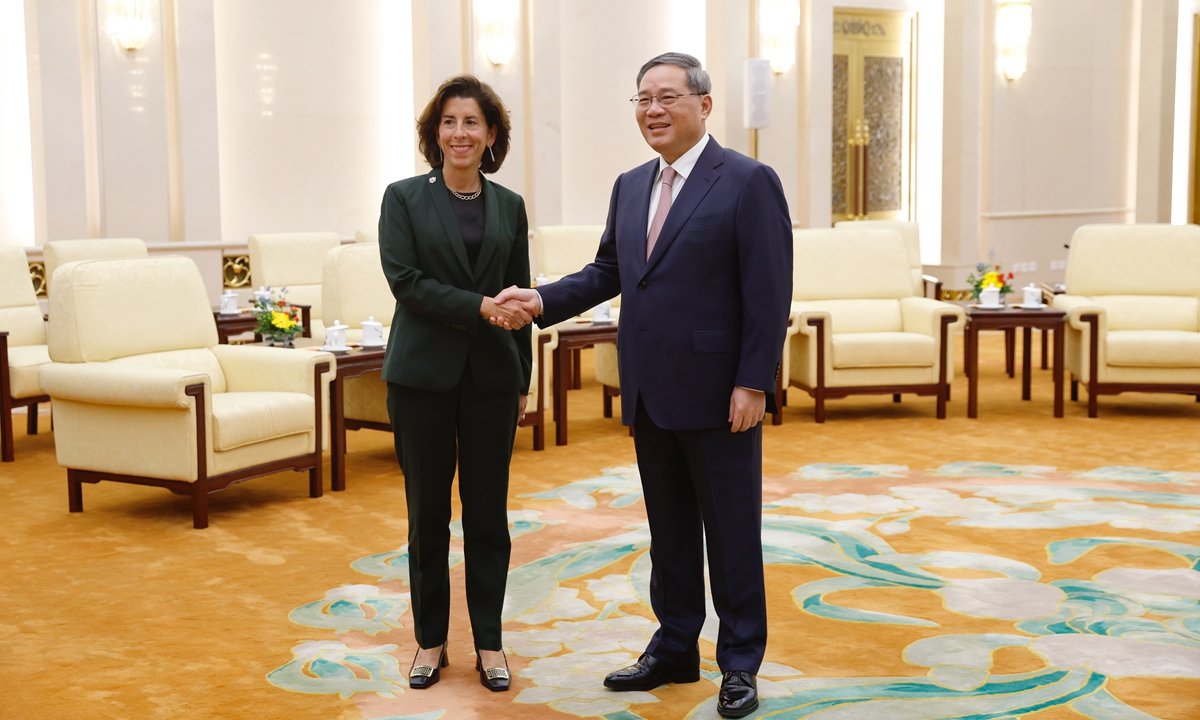China-US Trade Relations: Hope Amid Uncertainties
Chinese Premier Li Qiang conveyed China’s intent for expanded dialogues on trade topics in his meeting with US Commerce Secretary Gina Raimondo in Beijing. This took place during Raimondo’s two-day China trip, where Premier Li highlighted the need for more decisive efforts from the US to nurture the growth of bilateral ties between these two global economic giants.
Li emphasized that the foundation for a harmonious China-US relationship lies in mutual respect, peaceful coexistence, and reciprocal cooperation. The Xinhua News Agency reported his assertion that the core of China-US economic and trade relationships is mutual benefit and win-win outcomes. “It is hoped that the US will meet China halfway,” Li remarked.
This top-tier meeting followed a series of what were described as “candid and constructive” discussions Raimondo had with other senior Chinese officials, including Vice Premier He Lifeng and Commerce Minister Wang Wentao. In her dialogue with He Lifeng, they agreed on maintaining communication and fostering concrete collaboration between businesses from both nations.
One significant outcome from the long discussion between Minister Wang and Raimondo was the agreement to initiate a new trade communication avenue. This would involve a specialized working group, bringing together officials and business figures from both countries, aiming to identify solutions to precise trade concerns.
As Raimondo wraps up her Beijing meetings, she plans to journey to Shanghai, accompanied by the US Ambassador to China, Nicholas Burns, as per a Reuters report.
Senior research fellow Zhou Mi, associated with the Chinese Academy of International Trade and Economic Cooperation, emphasized the significance of these high-level dialogues in dispelling misunderstandings. Zhou highlighted the introduction of the new working group as a tangible advancement compared to past engagements. This presents a potential pathway for finding common ground, given the current icy diplomatic landscape.
Steps Forward in Economic Collaboration
Although no comprehensive details have been made public, an initial discussion on establishing a communication mechanism for export controls took place in Beijing. He Jun, a senior researcher at Anbound think tank, anticipates some thawing in economic and trade sectors, indicating mutual interests at play.
A promising development came when China’s Minister of Culture and Tourism, Hu Heping, met with Raimondo. They consented to host a high-level tourism dialogue in early 2024, aiming to stimulate the travel industry revival between China and the US. Both nations have already augmented the frequency of flights and plan to further this expansion.
China’s Ministry of Culture and Tourism stressed the hope that both countries can boost direct flight connections, streamline visa processes for Chinese citizens, and ensure a pleasant travel experience for both Chinese and American tourists.
Industry analysts project that Raimondo’s trip might stimulate an uptick in business activities and travel, thereby setting the stage for augmented economic and trade interactions.
Zhou Mi elaborated on the broader implications, “Reopening channels of communication is pivotal not just for bilateral relations but for global economic stability and reinstating investor confidence.”
During their discussions, Raimondo clarified the Biden administration’s stance: they don’t aim to hinder China’s progress or decouple from it. The focus is on maintaining open channels and ensuring that the economic and trade relationship remains robust. However, Zhou indicated that while these meetings are a step forward, they don’t guarantee an immediate resolution to existing differences.
Navigating the Roadblocks
While these meetings have infused a fresh dose of optimism, there are challenges. Many believe that further progress hinges on the US’s willingness to reevaluate its stringent restrictions and tariffs on Chinese entities.
Dean Sang Baichuan from the University of International Business and Economics in Beijing remarked on the absence of any alteration in the US’s approach, which continues to frame interactions under a national security lens. This makes forward movement tricky.
The onus for concrete advancement might be on the US, particularly if it considers rolling back investment limitations on Chinese tech firms, suggesting genuine commitment to collaboration. An executive order signed by President Biden, which curtails US investments in China in certain tech domains, has been met with considerable resistance from the US corporate sector.
However, despite the political and diplomatic roadblocks, the economic interdependence between China and the US is undeniable. He Jun highlighted the intertwined nature of the economies and the inability of American businesses to truly distance themselves from China. Experts advocate that recognizing this profound integration is essential, emphasizing that both nations stand to benefit from cooperation, while confrontation would be detrimental. They hope for a return to free trade principles sooner rather than later.
Read More:
